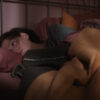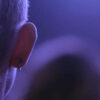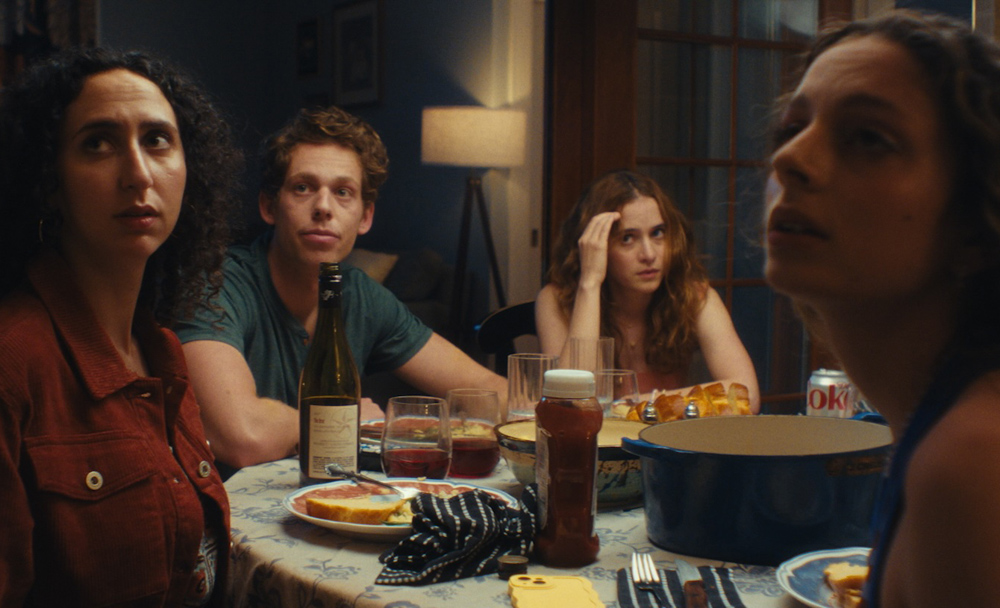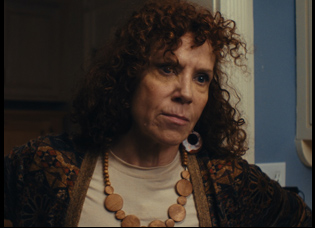There are a thousand tiny deaths at the dinner table in “Fire at Will” shortly after Seth (Scott Cohen) announces that he and his wife Debbie (Amy Stiller) have gathered their family to go over their final will and testament. In Morgan Gruer’s gloriously chaotic comedy, the announcement doesn’t come because the parents know something about their health that the children don’t, but rather an only slightly less shocking development has occurred – the homebound couple has made plans to safari in Africa and want to be assured that their affairs are in order before they leave should tragedy strike, which given how much else seems out of character for this particular clan, doesn’t seem entirely irrational. However, when the family can’t even entirely agree on what they’ll have for dinner even a brisket has been made and the youngest Daisy (Julia DiCesare) still insists on eating chicken nuggets, it is unlikely to be a smooth exchange about who gets what, particularly when out of the four siblings, three are triplets and as Seth and Debbie have decided, only two — Timmy (Lucas Zelnick) and Heather (Ellie Sachs) — are responsible enough to be executors.
While being an artist is seen as a liability for Maggie, the odd one out when it comes to being entrusted with handling the estate, it is clearly a strength for Gruer, who was inspired by a similar situation in real life to open the doors to a story of fraught family dynamics. The 10-minute short may not ever stray far from where the family sits down to eat, but roams all over the place dramatically as the parents’ final wishes reflect how they see their children after showing nothing but encouragement throughout the years and in spite of the rocky conversation, the film elegantly slides from one perspective to another to show where everyone in the family stands. The director, who has previously brought a lot of mixed media into her work, makes something no less animated — at least in spirit — as the family of big personalities all have their say, showing their individuality as they think nothing of talking over one another, and although there may not be any agreement reached by the end of the night, “Fire at Will” is quite agreeable as it considers a moment in which honesty can’t be avoided.
With “Fire at Will” premiering this week at Tribeca as part of the Shorts: Family Matters program, Gruer spoke about how she tired her own chagrin into something to smile about, conceiving the camerawork that could cover the wild scene around the dinner table and letting her own family see a reflection of themselves on screen.
A lot of this film is based on a true story with some embellishments. My parents, who never travel, were going on a big trip to Africa for my dad’s birthday and just in case they died on vacation or got eaten by a lion — I don’t know — they decided to gather us all to figure out the will and I should mention that I’m a triplet and as a triplet, things are usually divided pretty equally by three. But during this call to solidify the family will, my parents decided that my brother and sister would be appointed as executors, leaving me out of the will. Their reasoning was that as the artist of the family, my intentions were not quite aligned and although I was very offended, I thought during the whole time this would make a great story. The real life event took place on a Zoom call, not at a dinner table, so during the call, I took notes for what would become the film and while I was initially offended, [I realized] ultimately perhaps they weren’t wrong, so that was really what started the film.
Is it a surreal process reimagining something involving your whole family for the screen?
Yeah, this was about my family with actors who look like my family and also we shot it in my childhood home, so maybe it is a twisted form of therapy. Initially, having all those resemblance to my family was very anxiety inducing, but by the end, I like to always tell my actors that although this is based on a true story, we’re turning it into our own version. I don’t like to limit actors by trying them that they need to try to be just one specific version of a person, but to really have space to turn it into their own characters.
A lot of your work before this has involved mixed media and didn’t depend on a variety of performances like this. Was it a different experience?
Yeah, this is definitely very different than past work I’ve done. I got my start in graphic design and animation and I really started [directing] with music video and commercials, so I was really interested in this exercise [where it’s] performance and characters and getting to dig deep into a narrative structure without any of the bells and whistles. When you’re at just one dinner table, you have to be really, really locked in and tight in your script, in your camera choices and in your shots because there’s nothing else to cut away to. It doesn’t work, so this was this was a challenge, but ultimately really, really fun to flex different muscles.
The coverage around the table is really exciting – you’ll do a lot of slides with the camera as opposed to cutting to a reaction. What was it like figuring out how to move around the space?
Yeah, that was certainly a challenge. I worked really closely with our Jared Levy, our amazing director of photography, to figure out what that coverage would be. Before we shot anything, we started with storyboards to break down the emotional beats, but they ended up not being super helpful because the camera was almost always roving, so it was hard to try to capture a storyboard. Before our full shoot, Jared and I actually shot the entire film on iPhone beforehand, just with friends and significant others as placeholders at the dinner table and then our editor Kyle Moriarty cut the whole piece together and Jared and I had been sitting together, trying to break down the emotional beats of the film and figuring out, “Okay, what are the parts that we want to be really fast paced and quick cut with the fast dialogue? And then where are the parts that we really want to have slower camera movements and let everything breathe?” We thought we had figured it out, but when we put it together, we realized none of it worked. So if we hadn’t shot that, the film would have been a completely different film. After that, we were able to go back to the drawing board and say, “Okay, what pieces are working? What do we need here?” We really edited as we went along. And then we had a rehearsal day as well with the actors, so by the time we got to the actual shooting, everything was pretty locked in and we had a really clear understanding of where the camera was going to be at all times.
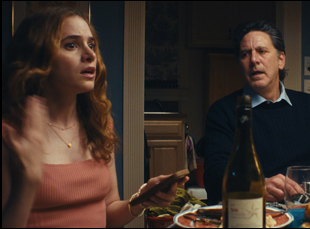
With rehearsals, I don’t like to over-rehearse and wear out the characters, but for something like blocking and the pacing of dialogue, rehearsals can be really important. So I try to actually not bring the character to the table so much and really take that out during rehearsals, but the dialogue has such a fast pace in this film — people are interrupting each other — and there’s a natural sense that happens with families where there’s a rhythm to it, so in order to get that rhythm, it’s got to be spoken enough times that it starts to feel natural. We really went through that with the table read and hopefully that translated.
It’s interesting to hear you actually shot this at your childhood home when you’re able to locate the action in this area where each of the characters has a different background behind them that can subtly highlight their differences. Was there much production design or did you know how the room could amplify who was sitting at the dinner table?
It was both. Initially, I really didn’t want to shoot at my parents’ house because I thought it would perhaps detract from the film. But as we were looking at locations and touring different spaces, it was really hard to find exactly what we were looking for. We wanted the whole film to take place around this dinner table, but at certain points, people get up and they go to different parts of the kitchen, so we needed a kitchen that had depth and texture. It should be lived in. There should be color. And there should be rooms offshooting from it, so my parents’ space ended up being perfect because the kitchen table was pretty centered, but there were all these rooms [opening up] from it and we were able to get those different looks.
We really did think about which characters should be at which part of the table to figure out what backgrounds suited them the most and we were really paying attention to this contrast between warm and cool tones, even going so far as [wondering] what color is their wardrobe, so that it can either contrast or blend into the background. We really went very deep into color theory. [laughs] So a lot of it was pretty intentional. But a lot of the things in the background were things that already existed in my parents’ house and we got really lucky in that we were able to use a lot of that to our advantage and lessen some of the workload of production design.
Was there anything that happened that you might not have expected but made it into the film that you really like about it?
For the most part, the film was very scripted and very dialed in. However, a lot of our cast are comedians in real life, so during our table read, when we were rehearsing the lines, we did a few exercises to loosen everyone up and in those exercises, many of these stand-up comedians brought hilarious lines to the table and we ended up using a few and inserting them into the script. Some of those lines are my favorite lines to this day.
I’m guessing you’d have to watch the film a few times to catch all the jokes that are flying with the overlapping dialogue. Was that fun to work on in the sound mix?
God bless our sound designer and mixer Calvin [Pia] because this was this was a project. We really wanted that frenetic energy of people speaking over and interrupting each other, but we also needed to be able to hear what people were saying, so it was definitely an exercise in picking out when people are overlapping dialogue and we had to pay attention to what are the lines that we actually want to hear and what are the lines that can get lost a little bit. We ended up shooting a lot of the scenes with actors individually where we would shoot one actor speaking at a time so we could have their audio clean and we had the option to then play with those levels in post-production. It came out really well.
Dare I ask, have you actually been able to show this to your family yet?
I have. I showed my family. We did a little home screening and I was nervous, but they took it in stride. And in the end, everyone thought it was really funny and everyone’s been very supportive, more supportive than I could have imagined. I think it takes a dig at all of the characters pretty equally, so by not singling anybody out and really just getting to explore the dynamic on screen, everyone got a kick out of it.
What’s it like getting this to Tribeca?
It’s been really special and rewarding that I made this. I thought it was just a little film about my family in terms of a very specific dynamic and specific characters, but it’s really resonated with so many people [already] and [it’s been good] just to remember that the dynamic that I think is really singular and individual is actually quite universal. I’m really excited to bring it to Tribeca. The next project we’re working on is creating a feature version of the same story with the same with the same characters in the same world, but an expanded story, so that’s the next big thing that we’re hoping to take this to.
“Fire at Will” will screen at the Tribeca Festival as part of the Shorts: Family Matters program on June 7th at 8 pm and June 11th at 9 pm at Shorts Theater at Spring Studios and June 14th at 2:15 pm and June 15th at 8:45 pm at AMC 19th St., East 6.
